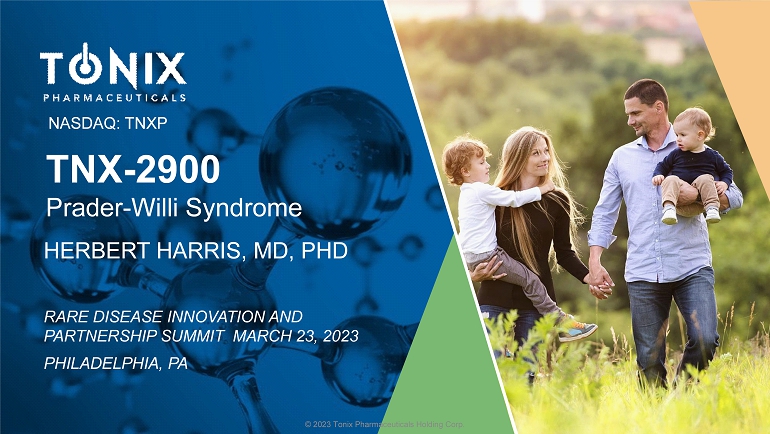
Tonix Pharmaceuticals Holding Corp. 8-K
Exhibit 99-02

© 2023 Tonix Pharmaceuticals Holding Corp. TNX - 2900 Prader - Willi Syndrome HERBERT HARRIS, MD, PHD RARE DISEASE INNOVATION AND PARTNERSHIP SUMMIT MARCH 23, 2023 PHILADELPHIA, PA NASDAQ: TNXP
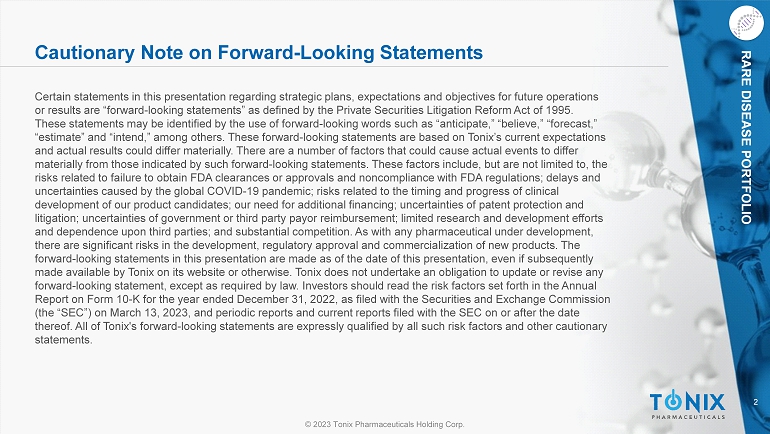
2 © 2023 Tonix Pharmaceuticals Holding Corp. RARE DISEASE PORTFOLIO Cautionary Note on Forward - Looking Statements Certain statements in this presentation regarding strategic plans, expectations and objectives for future operations or results are “forward - looking statements” as defined by the Private Securities Litigation Reform Act of 1995. These statements may be identified by the use of forward - looking words such as “anticipate,” “believe,” “forecast,” “estimate” and “intend,” among others. These forward - looking statements are based on Tonix’s current expectations and actual results could differ materially. There are a number of factors that could cause actual events to differ materially from those indicated by such forward - looking statements. These factors include, but are not limited to, the risks related to failure to obtain FDA clearances or approvals and noncompliance with FDA regulations; delays and uncertainties caused by the global COVID - 19 pandemic; risks related to the timing and progress of clinical development of our product candidates; our need for additional financing; uncertainties of patent protection and litigation; uncertainties of government or third party payor reimbursement; limited research and development efforts and dependence upon third parties; and substantial competition. As with any pharmaceutical under development, there are significant risks in the development, regulatory approval and commercialization of new products. The forward - looking statements in this presentation are made as of the date of this presentation, even if subsequently made available by Tonix on its website or otherwise. Tonix does not undertake an obligation to update or revise any forward - looking statement, except as required by law. Investors should read the risk factors set forth in the Annual Report on Form 10 - K for the year ended December 31, 2022, as filed with the Securities and Exchange Commission (the “SEC”) on March 13, 2023, and periodic reports and current reports filed with the SEC on or after the date thereof. All of Tonix's forward - looking statements are expressly qualified by all such risk factors and other cautionary statements.
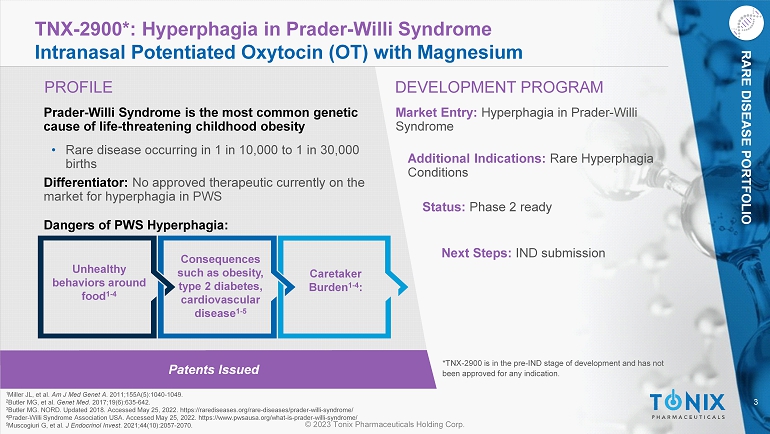
3 © 2023 Tonix Pharmaceuticals Holding Corp. RARE DISEASE PORTFOLIO Patents Issued PROFILE DEVELOPMENT PROGRAM TNX - 2900*: Hyperphagia in Prader - Willi Syndrome Intranasal Potentiated Oxytocin (OT) with Magnesium Prader - Willi Syndrome is the most common genetic cause of life - threatening childhood obesity • Rare disease occurring in 1 in 10,000 to 1 in 30,000 births Differentiator: No approved therapeutic currently on the market for hyperphagia in PWS Dangers of PWS Hyperphagia: Market Entry: Hyperphagia in Prader - Willi Syndrome Additional Indications: Rare Hyperphagia Conditions Status: Phase 2 ready Next Steps: IND submission *TNX - 2900 is in the pre - IND stage of development and has not been approved for any indication. Caretaker Burden 1 - 4 : Unhealthy behaviors around food 1 - 4 Consequences such as obesity, type 2 diabetes, cardiovascular disease 1 - 5 1 Miller JL, et al. Am J Med Genet A . 2011;155A(5):1040 - 1049. 2 Butler MG, et al. Genet Med. 2017;19(6):635 - 642. 3 Butler MG. NORD. Updated 2018. Accessed May 25, 2022. https://rarediseases.org/rare - diseases/prader - willi - syndrome/ 4 Prader - Willi Syndrome Association USA. Accessed May 25, 2022. https://www.pwsausa.org/what - is - prader - willi - syndrome/ 5 Muscogiuri G, et al. J Endocrinol Invest . 2021;44(10):2057 - 2070.
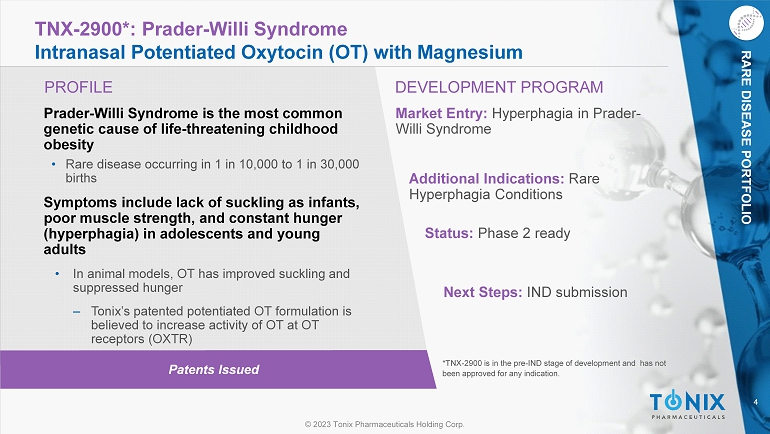
4 © 2023 Tonix Pharmaceuticals Holding Corp. RARE DISEASE PORTFOLIO Patents Issued PROFILE DEVELOPMENT PROGRAM TNX - 2900*: Prader - Willi Syndrome Intranasal Potentiated Oxytocin (OT) with Magnesium Prader - Willi Syndrome is the most common genetic cause of life - threatening childhood obesity • Rare disease occurring in 1 in 10,000 to 1 in 30,000 births Symptoms include lack of suckling as infants, poor muscle strength, and constant hunger (hyperphagia) in adolescents and young adults • In animal models, OT has improved suckling and suppressed hunger ‒ Tonix’s patented potentiated OT formulation is believed to increase activity of OT at OT receptors (OXTR) Market Entry: Hyperphagia in Prader - Willi Syndrome Additional Indications: Rare Hyperphagia Conditions Status: Phase 2 ready Next Steps: IND submission *TNX - 2900 is in the pre - IND stage of development and has not been approved for any indication.
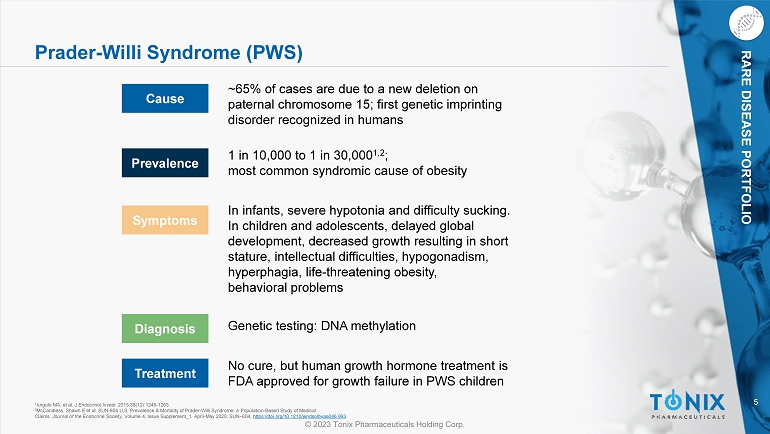
5 © 2023 Tonix Pharmaceuticals Holding Corp. RARE DISEASE PORTFOLIO Prader - Willi Syndrome (PWS) Cause Prevalence Symptoms a 65% of cases are due to a new deletion on paternal chromosome 15; first genetic imprinting disorder recognized in humans Diagnosis 1 in 10,000 to 1 in 30,000 1,2 ; most common syndromic cause of obesity In infants, severe hypotonia and difficulty sucking. In children and adolescents, delayed global development, decreased growth resulting in short stature, intellectual difficulties, hypogonadism, hyperphagia, life - threatening obesity, behavioral problems Genetic testing: DNA methylation 1 Angulo MA, et al. J Endocrinol Invest. 2015;38(12):1249 - 1263. 2 McCandless, Shawn E et al. SUN - 604 U.S. Prevalence & Mortality of Prader - Willi Syndrome: A Population - Based Study of Medical Claims, Journal of the Endocrine Society , Volume 4, Issue Supplement_1, April - May 2020, SUN – 604, https://doi.org/10.1210/jendso/bvaa046.993 Treatment No cure, but human growth hormone treatment is FDA approved for growth failure in PWS children
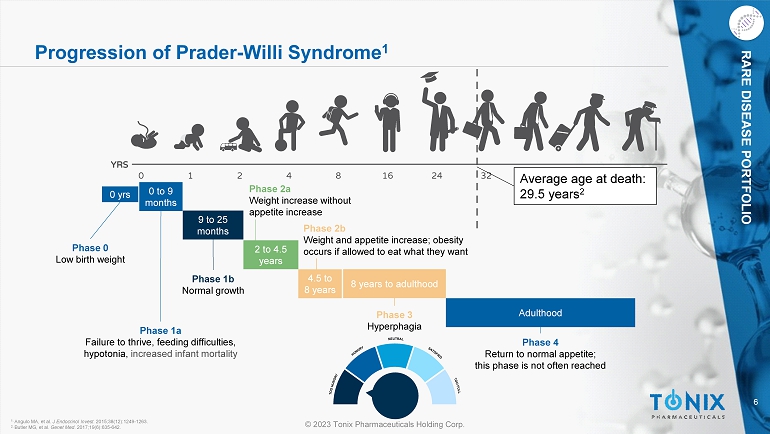
6 © 2023 Tonix Pharmaceuticals Holding Corp. RARE DISEASE PORTFOLIO Progression of Prader - Willi Syndrome 1 0 yrs 0 to 9 months 9 to 25 months 2 to 4.5 years 4.5 to 8 years 8 years to adulthood Adulthood Average age at death: 29.5 years 2 Phase 0 Low birth weight Phase 1a Failure to thrive, feeding difficulties, hypotonia, increased infant mortality Phase 1b Normal growth Phase 2a Weight increase without appetite increase Phase 2b Weight and appetite increase; obesity occurs if allowed to eat what they want Phase 3 Hyperphagia Phase 4 Return to normal appetite; this phase is not often reached 1. Angulo MA, et al. J Endocrinol Invest. 2015;38(12):1249 - 1263. 2. Butler MG, et al. Genet Med . 2017;19(6):635 - 642.

7 © 2023 Tonix Pharmaceuticals Holding Corp. RARE DISEASE PORTFOLIO Dangers of PWS Hyperphagia Caretaker Burden 1 - 4 : • 24/7 supervision • Restricted food intake • Low - calorie diet • Locking cabinets and refrigerators Behaviors around food 1 - 4 : • Foraging or hoarding • Temper tantrums and meltdowns • Binge eating • Stealing or stealing money to buy food • Eating garbage/spoiled food • Obsessions and compulsions Consequences 1 - 5 : • Life - threatening obesity • Risk of choking or gastrointestinal perforation • Food - borne illness • Chronic constipation • Swallowing difficulties • Decreased ability to vomit • Type 2 diabetes • Cardiovascular disease There is no treatment for PWS - related hyperphagia 4 1. Miller JL, et al. Am J Med Genet A . 2011;155A(5):1040 - 1049. 2. Butler MG, et al. Genet Med. 2017;19(6):635 - 642. 3. Butler MG. NORD. Updated 2018. Accessed May 25, 2022. https://rarediseases.org/rare - diseases/prader - willi - syndrome/ 4. Prader - Willi Syndrome Association USA. Accessed May 25, 2022. https://www.pwsausa.org/what - is - prader - willi - syndrome/ 5. Muscogiuri G, et al. J Endocrinol Invest . 2021;44(10):2057 - 2070.
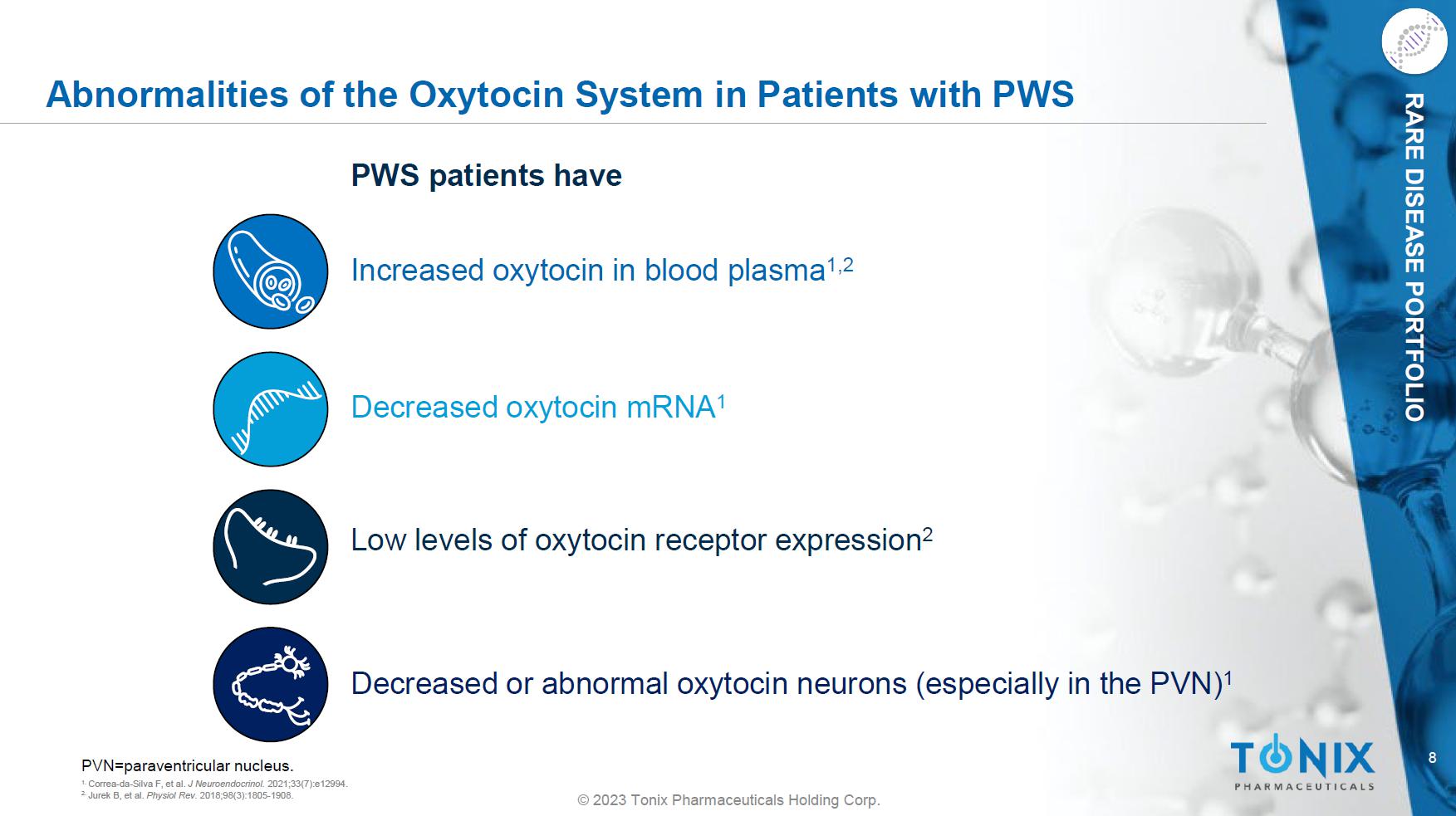
8 © 2023 Tonix Pharmaceuticals Holding Corp. RARE DISEASE PORTFOLIO Abnormalities of the Oxytocin System in Patients with PWS 1. Correa - da - Silva F, et al. J Neuroendocrinol . 2021;33(7):e12994. 2. Jurek B, et al. Physiol Rev . 2018;98(3):1805 - 1908. PWS patients have PVN=paraventricular nucleus. Increased oxytocin in blood plasma 1,2 Decreased or abnormal oxytocin neurons (especially in the PVN) 1 Decreased oxytocin mRNA 1 Low levels of oxytocin receptor expression 2
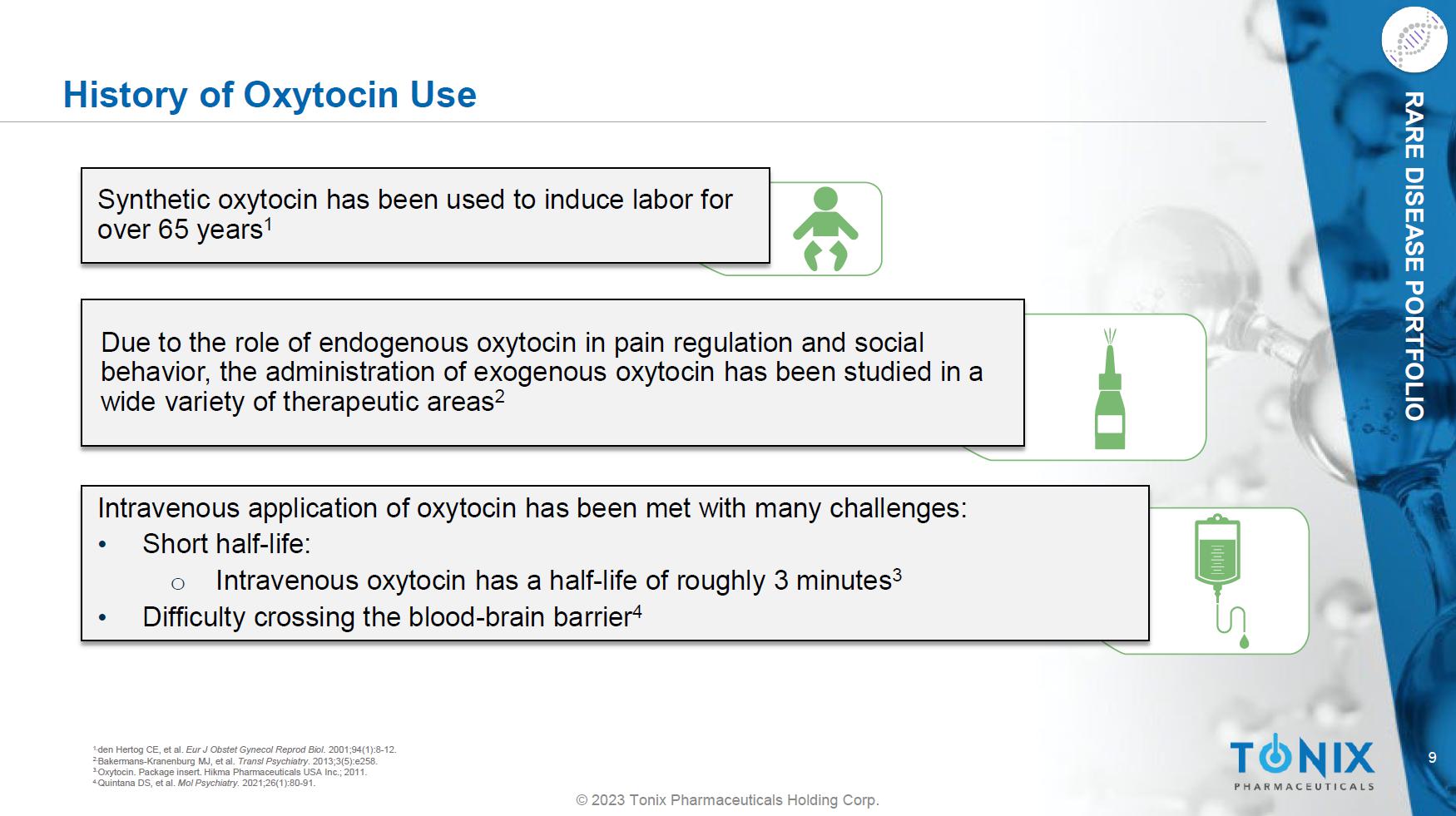
9 © 2023 Tonix Pharmaceuticals Holding Corp. RARE DISEASE PORTFOLIO History of Oxytocin Use 1. den Hertog CE, et al. Eur J Obstet Gynecol Reprod Biol . 2001;94(1):8 - 12. 2. Bakermans - Kranenburg MJ, et al. Transl Psychiatry . 2013;3(5):e258. 3. Oxytocin. Package insert. Hikma Pharmaceuticals USA Inc.; 2011. 4. Quintana DS, et al. Mol Psychiatry. 2021;26(1):80 - 91. Due to the role of endogenous oxytocin in pain regulation and social behavior, the administration of exogenous oxytocin has been studied in a wide variety of therapeutic areas 2 Intravenous application of oxytocin has been met with many challenges: • Short half - life: o Intravenous oxytocin has a half - life of roughly 3 minutes 3 • Difficulty crossing the blood - brain barrier 4 Synthetic oxytocin has been used to induce labor for over 65 years 1
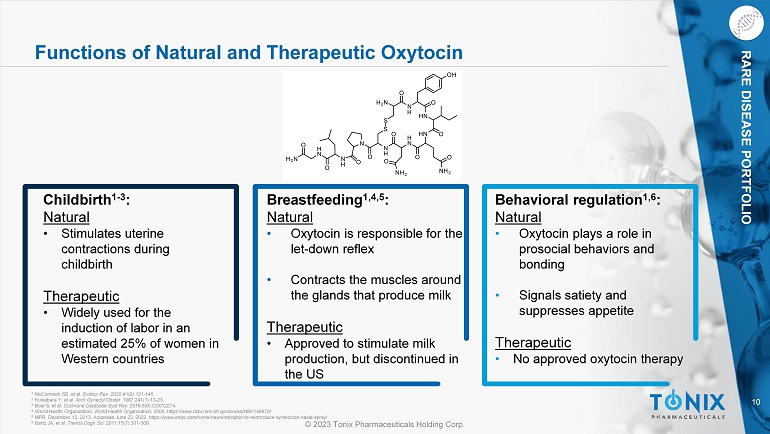
10 © 2023 Tonix Pharmaceuticals Holding Corp. RARE DISEASE PORTFOLIO Functions of Natural and Therapeutic Oxytocin 1. McCormack SE , et al. Endocr Rev. 2020;41(2):121 - 145. 2. Kuwabara Y, et al. Arch Gynecol Obstet . 1987;241(1):13 - 23. 3. Boie S, et al. Cochrane Database Syst Rev . 2018;8(8):CD012274. 4. World Health Organization. World Health Organization; 2009. https://www.ncbi.nlm.nih.gov/books/NBK148970/ 5. MPR. December 12, 2013. Accessed June 23, 2022. https://www.empr.com/home/news/retrophin - to - reintroduce - syntocinon - nasal - spray/ 6. Bartz JA, et al. Trends Cogn Sci . 2011;15(7):301 - 309. Childbirth 1 - 3 : Natural • Stimulates uterine contractions during childbirth Therapeutic • Widely used for the induction of labor in an estimated 25% of women in Western countries Breastfeeding 1,4,5 : Natural • Oxytocin is responsible for the let - down reflex • Contracts the muscles around the glands that produce milk Therapeutic • Approved to stimulate milk production, but discontinued in the US Behavioral regulation 1,6 : Natural • Oxytocin plays a role in prosocial behaviors and bonding • Signals satiety and suppresses appetite Therapeutic • No approved oxytocin therapy
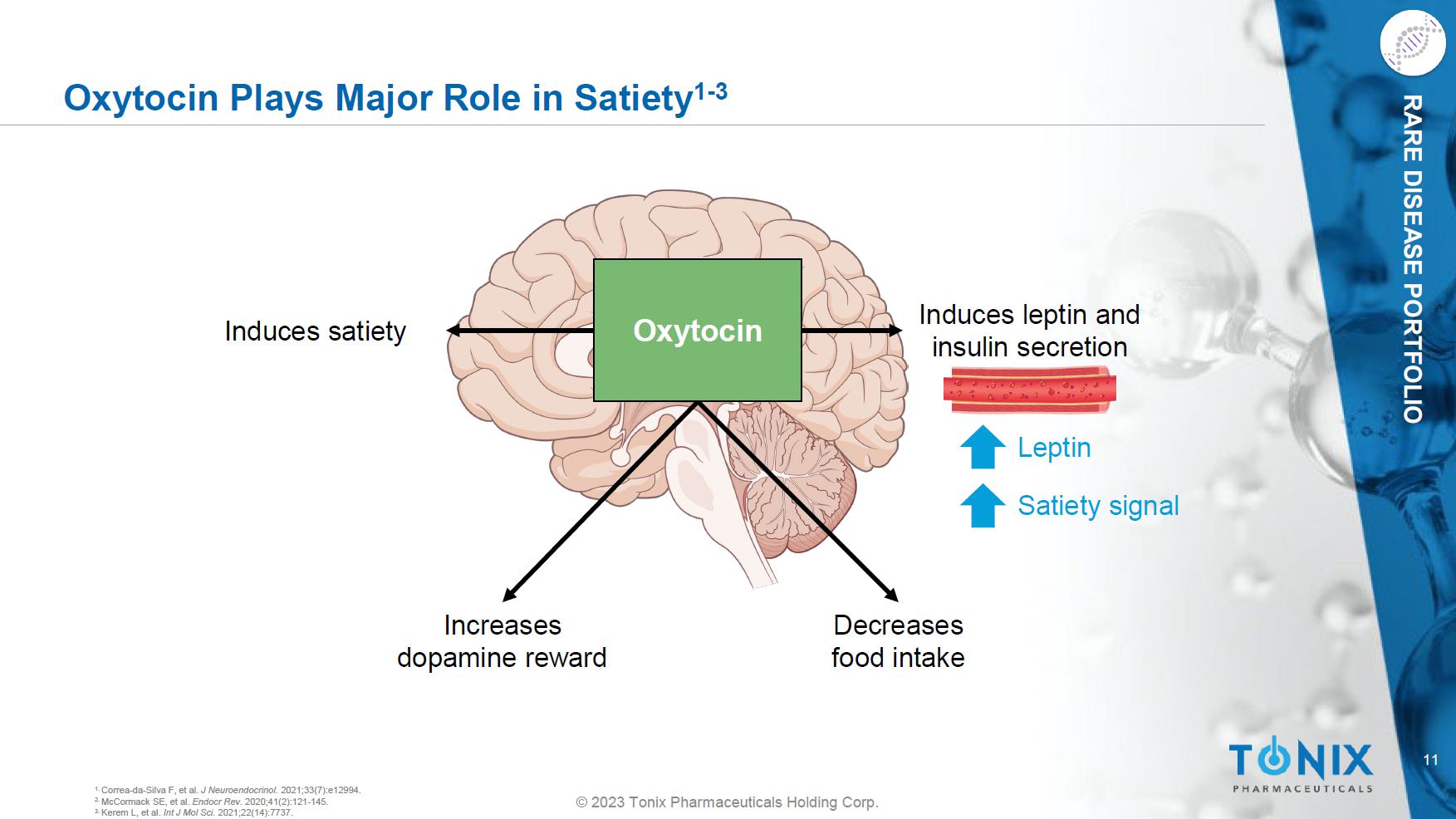
11 © 2023 Tonix Pharmaceuticals Holding Corp. RARE DISEASE PORTFOLIO Oxytocin Plays Major Role in Satiety 1 - 3 1. Correa - da - Silva F, et al. J Neuroendocrinol . 2021;33(7):e12994. 2. McCormack SE , et al. Endocr Rev. 2020;41(2):121 - 145. 3. Kerem L, et al. Int J Mol Sci. 2021;22(14):7737 . Oxytocin Increases dopamine reward Decreases food intake Induces leptin and insulin secretion Leptin Satiety signal Induces satiety
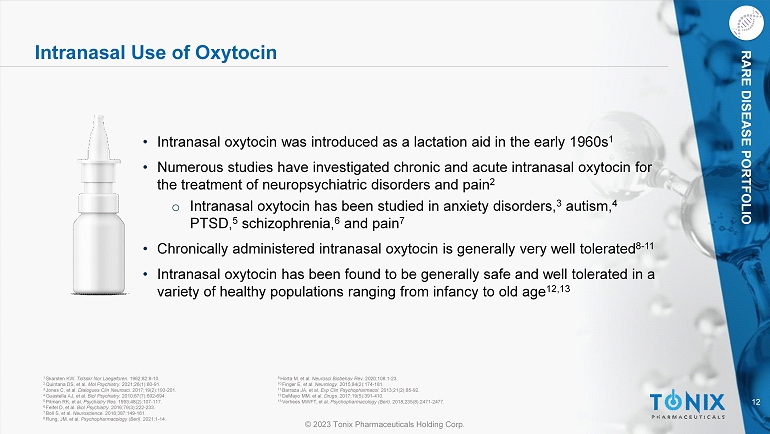
12 © 2023 Tonix Pharmaceuticals Holding Corp. RARE DISEASE PORTFOLIO Intranasal Use of Oxytocin • Intranasal oxytocin was introduced as a lactation aid in the early 1960s 1 • Numerous studies have investigated chronic and acute intranasal oxytocin for the treatment of neuropsychiatric disorders and pain 2 o Intranasal oxytocin has been studied in anxiety disorders, 3 autism, 4 PTSD, 5 schizophrenia, 6 and pain 7 • Chronically administered intranasal oxytocin is generally very well tolerated 8 - 11 • Intranasal oxytocin has been found to be generally safe and well tolerated in a variety of healthy populations ranging from infancy to old age 12,13 1. Skarsten KW. Tidsskr Nor Laegeforen . 1962;82:8 - 10. 2. Quintana DS, et al. Mol Psychiatry . 2021;26(1):80 - 91. 3. Jones C, et al. Dialogues Clin Neurosci . 2017;19(2):193 - 201. 4. Guastella AJ, et al. Biol Psychiatry. 2010;67(7):692 - 694. 5. Pitman RK, et al. Psychiatry Res. 1993;48(2):107 - 117. 6. Feifel D, et al. Biol Psychiatry . 2016;79(3):222 - 233. 7. Boll S, et al. Neuroscience . 2018;387:149 - 161. 8. Rung, JM, et al. Psychopharmacology (Berl). 2021;1 - 14. 9. Horta M, et al. Neurosci Biobehav Rev. 2020;108:1 - 23. 10. Finger E, et al. Neurology. 2015;84(2):174 - 181. 11. Barraza JA, et al. Exp Clin Psychopharmacol . 2013;21(2):85 - 92. 12. DeMayo MM, et al. Drugs . 2017;19(5):391 - 410. 13. Verhees MWFT, et al. Psychopharmacology (Berl). 2018;235(8):2471 - 2477.
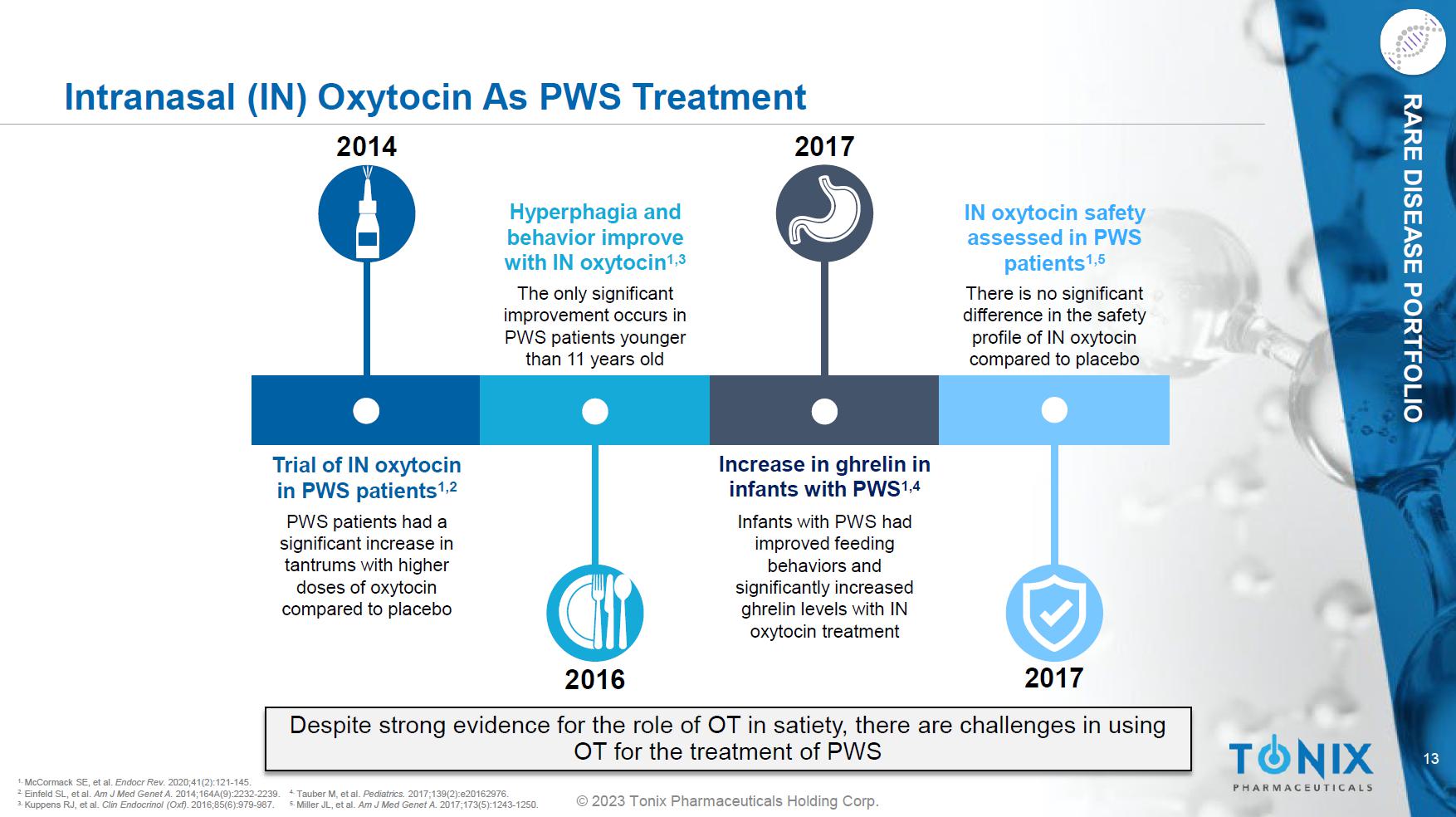
13 © 2023 Tonix Pharmaceuticals Holding Corp. RARE DISEASE PORTFOLIO Intranasal (IN) Oxytocin As PWS Treatment 1. McCormack SE , et al. Endocr Rev. 2020;41(2):121 - 145. 2. Einfeld SL, et al. Am J Med Genet A. 2014;164A(9):2232 - 2239. 3. Kuppens RJ, et al. Clin Endocrinol ( Oxf ). 2016;85(6):979 - 987. Despite strong evidence for the role of OT in satiety, there are challenges in using OT for the treatment of PWS 2014 Trial of IN oxytocin in PWS patients 1,2 PWS patients had a significant increase in tantrums with higher doses of oxytocin compared to placebo Hyperphagia and behavior improve with IN oxytocin 1,3 2016 The only significant improvement occurs in PWS patients younger than 11 years old Increase in ghrelin in infants with PWS 1,4 2017 Infants with PWS had improved feeding behaviors and significantly increased ghrelin levels with IN oxytocin treatment IN oxytocin safety assessed in PWS patients 1,5 2017 There is no significant difference in the safety profile of IN oxytocin compared to placebo 4. Tauber M, et al. Pediatrics. 2017;139(2):e20162976. 5. Miller JL, et al. Am J Med Genet A . 2017;173(5):1243 - 1250.
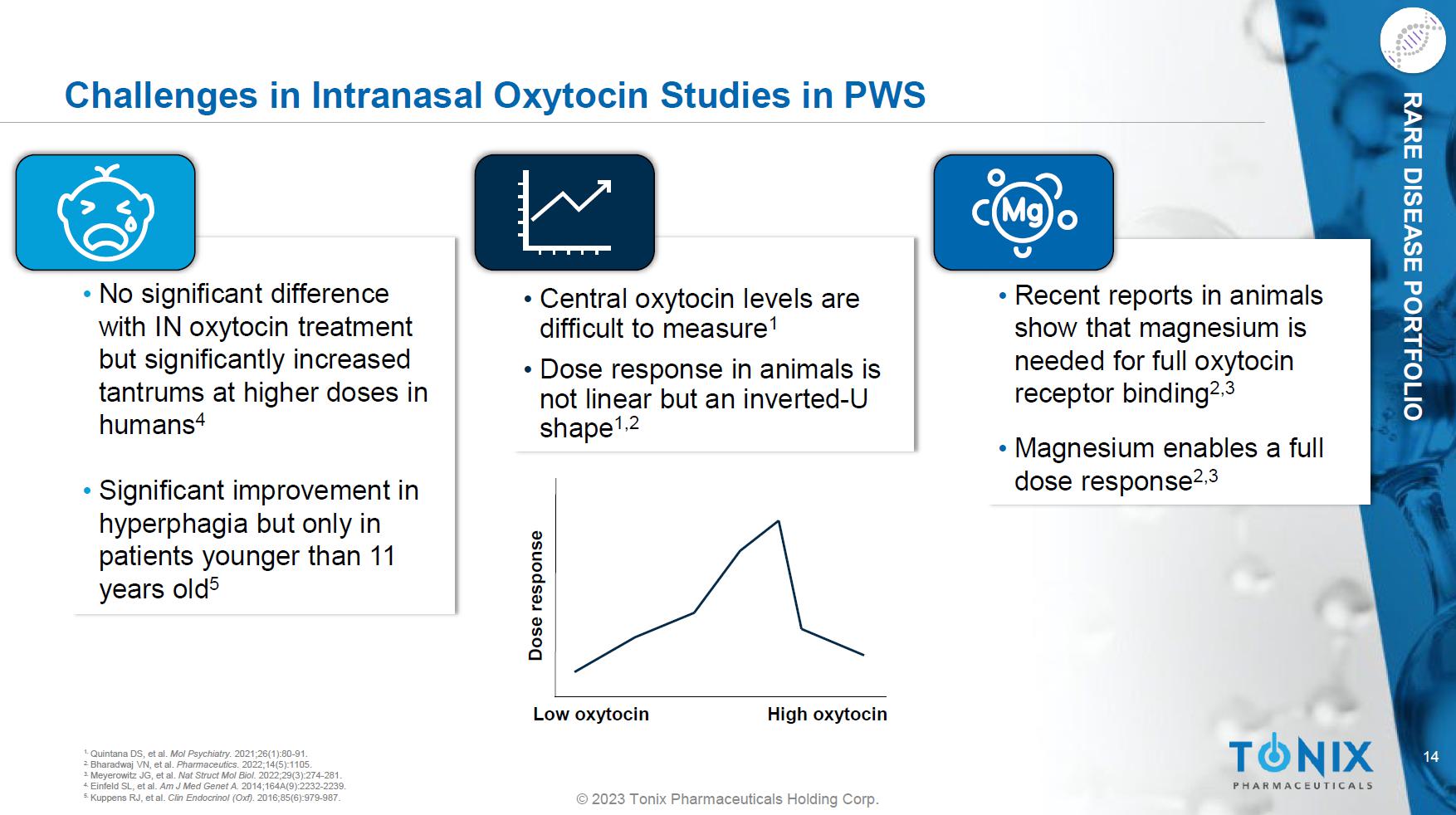
14 © 2023 Tonix Pharmaceuticals Holding Corp. RARE DISEASE PORTFOLIO Challenges in Intranasal Oxytocin Studies in PWS 1. Quintana DS, et al. Mol Psychiatry. 2021;26(1):80 - 91. 2. Bharadwaj VN, et al. Pharmaceutics. 2022;14(5):1105. 3. Meyerowitz JG, et al. Nat Struct Mol Biol . 2022;29(3):274 - 281. 4. Einfeld SL, et al. Am J Med Genet A. 2014;164A(9):2232 - 2239. 5. Kuppens RJ, et al. Clin Endocrinol ( Oxf ). 2016;85(6):979 - 987. • No significant difference with IN oxytocin treatment but significantly increased tantrums at higher doses in humans 4 • Significant improvement in hyperphagia but only in patients younger than 11 years old 5 • Recent reports in animals show that magnesium is needed for full oxytocin receptor binding 2,3 • Magnesium enables a full dose response 2,3 • Central oxytocin levels are difficult to measure 1 • Dose response in animals is not linear but an inverted - U shape 1,2 Dose response Low oxytocin High oxytocin

15 © 2023 Tonix Pharmaceuticals Holding Corp. RARE DISEASE PORTFOLIO Oxytocin Receptor (OXTR) 1 Jurek B, et al. Physiol Rev . 2018;98(3):1805 - 1908. 2 Meyerowitz JG, et al. Nat Struct Mol Biol. 2022;29(3):274 - 281. OXTR Signaling Cascade OXTR G q /11 Phospho - lipase C Ca 2+ Protein synthesis Unknown EGFR MAPK Oxytocin EGFR=epidermal growth factor receptor; MAPK=mitogen activated protein kinase; OXTR=oxytocin receptor 0.79 6.62 11 7 58.4 0 10 20 30 40 50 60 70 80 OXTR Binding to Agonists 1 K i values, nM (SD) Receptor agonists Oxytocin TGOT = highly selective agonist Atosiban = functionally selective agonist (can act as an antagonist depending on the G - protein coupled to OXTR) Carbetocin = oxytocin analog – weak agonist with mixed antagonist activity 2 WAY 267,464 = nonpeptide agonist more specific for the vasopressin receptor
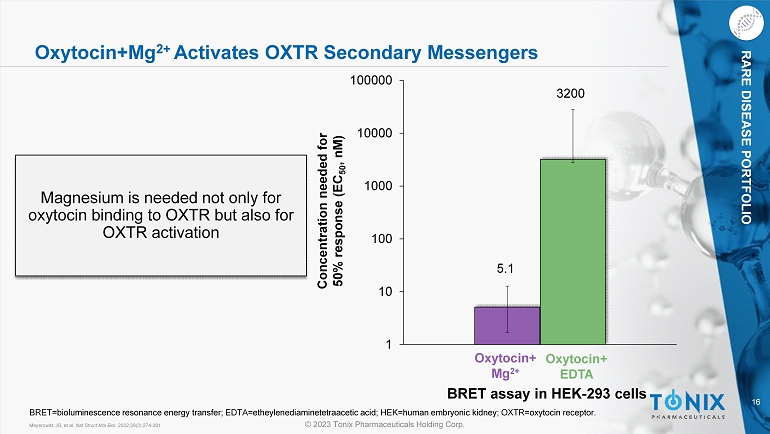
16 © 2023 Tonix Pharmaceuticals Holding Corp. RARE DISEASE PORTFOLIO Oxytocin+Mg 2+ Activates OXTR Secondary Messengers Magnesium is needed not only for oxytocin binding to OXTR but also for OXTR activation BRET=bioluminescence resonance energy transfer; EDTA= etheylenediaminetetraacetic acid; HEK=human embryonic kidney; OXTR=oxytocin receptor. Meyerowitz JG, et al. Nat Struct Mol Biol. 2022;29(3):274 - 281. 5.1 3200 1 10 100 1000 10000 100000 Oxytocin+ Mg 2+ Oxytocin+ EDTA BRET assay in HEK - 293 cells Concentration needed for 50% response (EC 50 , nM )
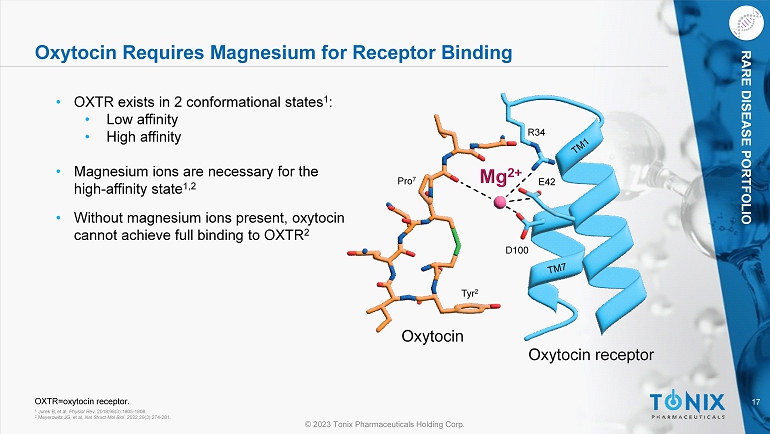
17 © 2023 Tonix Pharmaceuticals Holding Corp. RARE DISEASE PORTFOLIO Oxytocin Requires Magnesium for Receptor Binding • OXTR exists in 2 conformational states 1 : • Low affinity • High affinity • Magnesium ions are necessary for the high - affinity state 1,2 • Without magnesium ions present, oxytocin cannot achieve full binding to OXTR 2 1. Jurek B, et al. Physiol Rev . 2018;98(3):1805 - 1908. 2. Meyerowitz JG, et al. Nat Struct Mol Biol. 2022;29(3):274 - 281. R34 E42 D100 Tyr 2 Pro 7 Oxytocin receptor Oxytocin OXTR=oxytocin receptor.
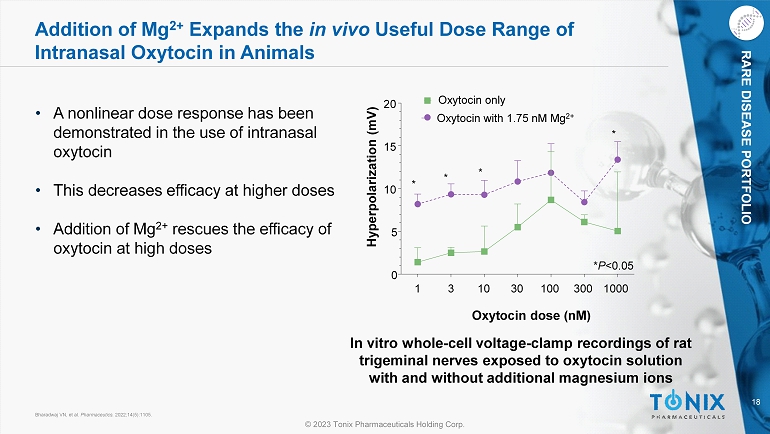
18 © 2023 Tonix Pharmaceuticals Holding Corp. RARE DISEASE PORTFOLIO Addition of Mg 2+ Expands the in vivo Useful Dose Range of Intranasal Oxytocin in Animals Bharadwaj VN, et al. Pharmaceutics . 2022;14(5):1105. • A nonlinear dose response has been demonstrated in the use of intranasal oxytocin • This decreases efficacy at higher doses • Addition of Mg 2+ rescues the efficacy of oxytocin at high doses 1 3 10 30 100 300 1000 0 5 10 15 20 Oxytocin only Oxytocin with 1.75 nM Mg 2+ * * * * Oxytocin dose ( nM ) Hyperpolarization (mV) In vitro whole - cell voltage - clamp recordings of rat trigeminal nerves exposed to oxytocin solution with and without additional magnesium ions * P <0.05
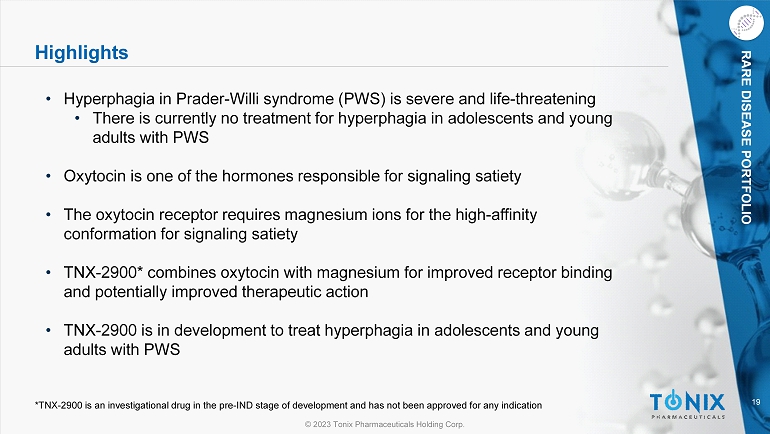
19 © 2023 Tonix Pharmaceuticals Holding Corp. RARE DISEASE PORTFOLIO Highlights • Hyperphagia in Prader - Willi syndrome (PWS) is severe and life - threatening • There is currently no treatment for hyperphagia in adolescents and young adults with PWS • Oxytocin is one of the hormones responsible for signaling satiety • The oxytocin receptor requires magnesium ions for the high - affinity conformation for signaling satiety • TNX - 2900* combines oxytocin with magnesium for improved receptor binding and potentially improved therapeutic action • TNX - 2900 is in development to treat hyperphagia in adolescents and young adults with PWS *TNX - 2900 is an investigational drug in the pre - IND stage of development and has not been approved for any indication

© 2023 Tonix Pharmaceuticals Holding Corp. THANK YOU